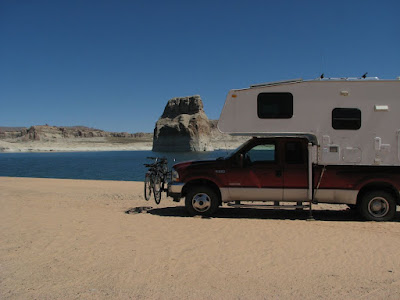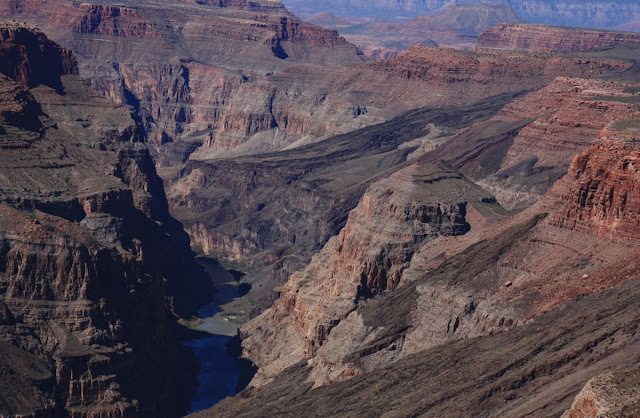How would you like to wake up to this view every morning?
This is the view from the camper on Lone Rock Beach in the Glen Canyon National Recreation area of Utah and Arizona. We decided it was time for a change of scenery, and perhaps a bit of kayaking. Lake Powell is the the lake that formed when the Glen Canyon Dam, completed in 1963, flooded Glen Canyon. To this day there is still much controversy about the Glen Canyon Dam. Many people feel that it took away one of the most beautiful canyons in the world to put golf courses in the desert. I can't speak knowledgeably to that question, but I can say that Lake Powell is a supremely beautiful place and I can believe that Glen Canyon must have been awesome.

 |
| Lone Rock Cave |
The beach is huge and, at this time of the year, pretty much empty.
We haven't done much beach camping and it was a real thrill for us to be here.
We set off the first day to explore Lone Rock and the far shore of the bay.
With no trees or familiar landmarks to provide an anchor for perception, the distances on Lake Powell are very deceiving. Lone Rock looked to be about ½ mile away. It took us 45 minutes to paddle to the rock, probably about 1½ to 2 miles.
On the far shore, invisible from our campsite, we found a small bay that led into a delightful slot canyon that we could kayak into. At times we could put our hands on both sides of the canyon and push our kayaks through.
On our second day we kayaked to Castle Rock, an island near the center of Wahweap Bay, about a 6 mile trip one way, but well worth the effort. The beautifully clear water, next to those towering white and red rock cliffs is just spectacular to see.
As you can see I am taking life seriously here in the west and working hard to have a good time. ⇒
⇐ Another cave. This one appeared to be about 12 feet deep to the cave floor, but with the water level where it was I could just barely fit into it.
Back at the campsite, just before the big wind that was due to show up, we shared a campfire with a wonderful family from Switzerland. They are on sabbatical, 10 months into a 12 month tour of the US, Mexico and Canada. They have seen more of the US in 10 months than most Americans will see in a lifetime. It must have been a terribly difficult decision to come to a foreign country, buy a truck and fifth wheel camper, and set off on their own, touring Cities, National Parks and Forests, and meeting lots of new friends along the way. Cheryl and I are very proud to know them .
 | |
| Eddy, Jenny, Cindy, Aline Bon Voyage |
| We have been so blessed in our travels to meet some of the world's nicest people. Well, shortly after the campfire the promised big wind showed up and blew us all the way north to Bryce Canyon National Park...More to come. |
































